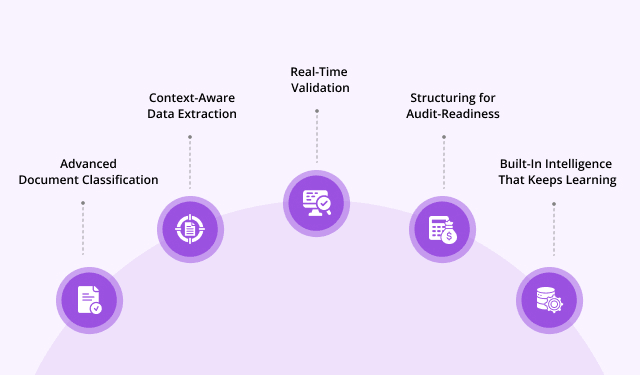Modern mortgage files are unpredictable. One borrower might upload tax returns; another might send a basic online statement. And if your system can’t interpret these differences intelligently, your team is left untangling errors that smart automation should’ve caught in seconds.
This is where document processing for mortgage operations either break down or set lenders apart. It’s not enough to scan and store; your system needs to read, understand, and act on the content with precision.
A recent Scotsman Guide report highlighted that lenders who invested in digital closing solutions saw noticeable improvements: over 80% reported faster closing times, fewer document errors, and better borrower satisfaction rates across the board.
Let’s break down 5 capabilities any modern mortgage document automation system must get right.

1. Advanced Document Classification
Before anything can be extracted or validated, your system needs to know what it’s looking at. That’s where classification makes or breaks efficiency. A robust document processing for mortgage setup should automatically identify a wide range of forms e.g. W-2s, bank statements, verification of employment, and insurance documents even when they vary in format or source. If your team still manually tags or sorts files, that’s not intelligent automation.
2. Context-Aware Data Extraction
It’s not enough to just find data, your system needs to understand what it means and where it belongs. Intelligent mortgage document automation should extract borrower names, income figures, account numbers, and dates with full awareness of their surrounding context. For example, it should know the difference between a borrower’s and co-borrower’s income on a tax return, even if they’re listed together. Systems that rely on static zones or templates often break with real-world documents. Context-aware extraction reduces those risks and saves your team from time-consuming corrections later.
3. Real-Time Validation
Errors caught late are expensive. Whether it’s a missing signature, outdated income document, or a mismatched ID, these issues often stall the loan file just when it’s ready to move forward. That’s why AI in mortgage processing must include real-time validation not just after the fact.
Your system should check incoming documents as they’re ingested: Are they complete? Do they meet investor or agency guidelines? Are the dates within range? Automating these steps ensures defects are caught early, minimizing rework and accelerating decisioning.
4. Structuring for Audit-Readiness
Compliance in mortgage is not just about having correct documents but it is about having them organized, accessible, and aligned with regulatory expectations.
That’s where audit-ready mortgage documentation becomes essential. Your automation system should not only extract and validate information but also file it in a standardized, searchable format that’s ready for audit without manual effort.
Whether it’s a repurchase review, investor check, or internal QA, lenders need confidence that documentation can be retrieved instantly and it’s complete, indexed, and defensible.
5. Built-In Intelligence That Keeps Learning
Legacy systems can process documents. But only intelligent ones can improve over time.
True AI in mortgage processing means more than automating repetitive tasks, it means adapting to new formats, recognizing shifting patterns, and learning from corrections. This becomes critical when document types or borrower behaviors change, especially in complex loan scenarios.
For lenders, this translates to fewer exceptions, faster processing cycles, and more resilient operations, all while keeping manual intervention to a minimum.
The right system doesn’t just keep up with the pace of change. It gets better with it.
How DocVu.AI Brings These Capabilities Together
Smart document automation is not just about individual features but it is about how they work together to reduce manual effort, minimize risk, and give your team more time to focus on decision making strategies, not data cleanup. And that’s where DocVu.AI makes a measurable difference.
- Context-aware data capture
Extracts the right values from the right places distinguishing between borrower, co-borrower, and irrelevant sections with precision. - Real-time checks at ingestion
Flags missing documents, outdated forms, and investor-specific exceptions before the file hits underwriting. - Audit-ready structuring
Automatically organizes extracted data and documentation into investor-compliant formats fully indexed and searchable. - Systems that learn and adapt
Continuously improves with usage, so your document processing becomes more resilient over time, not just more automated.
Final Thoughts
Intelligent document processing is not just a buzzword, it’s a practical necessity for mortgage lenders navigating today’s operational complexity. From classifying non-standard file types to validating data before it causes downstream delays, the right system should do more than just digitize. It should interpret, structure, and evolve just like your lending business does.
That’s where DocVu.AI comes in. We’ve built our platform specifically for mortgage operations, combining AI-driven precision with compliance-grade audit readiness. The result: faster onboarding, fewer manual touchpoints, and better control across the loan lifecycle.






